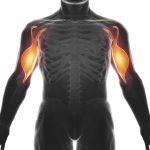
Pop! You just felt something pop in your elbow or upper arm. Sometimes the pain is minimal, but that pop must have been something, right? It kind of hurts to bend your elbow or lift your arm and you are starting to notice swelling and bruising around the front of your elbow or forearm. What should you do? Call your doctor for an appointment! Chances are you ruptured your biceps tendon. There are several treatment options you and your doctor could talk about depending on whether the tendon was injured at the elbow or shoulder. Let’s look at some anatomy and then we will talk about some treatment options.
At the Shoulder: Proximal Biceps Rupture
Your upper arm bone and shoulder blade together with the collarbone make up the shoulder complex. The bicep tendon has two heads, a long head that crosses over the front of the shoulder and attaches to the top of the shoulder joint, and the short head that attaches to the shoulder blade outside the shoulder joint. Of the two, the long head of the biceps (inside the joint) is the most likely to tear due to falling on the arm, lifting too heavy of an object, overuse, or from degeneration over time with arthritis.

At the Elbow: Distal Biceps Rupture
Like at the shoulder, there are three bones that make up the elbow joint: the lower end of your upper arm bone, and the two forearm bones, the radius and the ulna. However, there is only one biceps tendon at the elbow that ruptures. The distal biceps tendon ruptures at its attachment at the radial tuberosity (bony bump of a bone in the lower arm). Injury is most often the result of the elbow being forced straight against resistance, or sometimes with heavy lifting.

Symptoms:
- Audible pop or snapping feeling
- Swelling, bruising, and weakness
- Tenderness at the shoulder or elbow
- Difficulty turning the palm up and down, bending the elbow, or raising the arm.
Both conditions can be treated with conservative measures. Implementing RICE and formal physical therapy or a home exercise program may help alleviate some pain and encourage normal arm function. At the shoulder, depending on where the rupture occurs, you may not need surgery. According to our very own Dr. Walker, “There will be a change in the contour of the muscle belly but function can be normal, unless there is a retained piece of tendon in the joint causing pain, catching, or locking.”
If there is no relief with conservative treatments, or other structures to the shoulder are damaged, surgery could be considered. The tendon inside of the joint is usually removed and the remaining tendon is anchored as it exits the shoulder. Precautions are taken to make sure the healed before any strengthening begins.
At the elbow, if a biceps tear is not repaired you will lose some ability to bend or flex the elbow. The most significant loss of strength will be with turning or twisting the forearm palm up or palm down. This tendon gets much harder to fix after several weeks, so time is important! The repair itself involves anchoring the tendon to the radius bone. Rehabilitation after surgery requires early motion with limits on how much weight can be lifted or pulled as the tendon heals. If you suspect that you have torn a tendon in the shoulder or arm, contact your doctor for an appointment today!
By: Riki Duncan, MA. Ed, ATC, LAT
Sources:
http://orthoinfo.aaos.org/topic.cfm?topic=a00376

